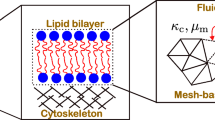Abstract
ACCORDING to the fluid mosaic model of membrane structure1, surface proteins are free to diffuse in a lipid matrix and thus to assume a random or homogenous distribution over the cell surface. In support of this model it has been shown that the distribution of glycoprotein receptors for the plant lectin concanavalin A (con A) is random in all cell types studied. In a variety of living systems it has also become clear that surface elements can be induced by exogenous agents to assume a non-random or heterogeneous distribution; for example, in virus transformed cells con A induces a clustering of con A binding sites. Recently, we and others have shown that cellular components sensitive to colchicine alkaloids (microtubules and perhaps other structures with similar pharmacological specificities) can affect the topography of certain surface elements. We shall review here the experimental evidence for systems in which topographical heterogeneity of specific surface elements (lectin binding sites and membrane transport carriers) can be induced and can be altered by colchicine. We shall then advance a general hypothesis involving specific interactions between surface proteins and intracellular colchicine binding proteins (CBP), which rationalises some apparent contradictions in this evidence and which indicates a molecular process at the level of the plasma membrane by which cells may respond to extracellular substances.
Similar content being viewed by others
References
Singer, S. J., and Nicolson, G. L., Science, N.Y., 175, 720 (1972).
Rosenblith, J. Z., Ukena, T. E., Yin, H. H., Berlin, R. D., and Karnovsky, M. J., Proc. natn. Acad. Sci. U.S.A., 70, 1625 (1973).
Yahara, I., and Edelman, G. M., Proc. natn. Acad. Sci. U.S.A., 69, 608 (1972).
Gunther, G. R., Wang, J. L., Yahara, I., Cunningham, B. A., and Edelman, G. M., Proc. natn. Acad. Sci. U.S.A., 70, 1012 (1973).
Edelman, G. M., Yahara, I., and Wang, J. L., Proc. natn. Acad. Sci. U.S.A., 70, 1442 (1973).
Tsan, M. F., and Berlin, R. D., J. exp. Med., 134, 1016 (1971).
Ukena, T. E., and Berlin, R. D., J. exp. Med., 136, 1 (1972).
Oliver, J. M., Ukena, T. E., and Berlin, R. D., Proc. natn. Acad. Sci. U.S.A. (in the press).
Author information
Authors and Affiliations
Rights and permissions
About this article
Cite this article
BERLIN, R., OLIVER, J., UKENA, T. et al. Control of Cell Surface Topography. Nature 247, 45–46 (1974). https://doi.org/10.1038/247045a0
Received:
Issue Date:
DOI: https://doi.org/10.1038/247045a0
- Springer Nature Limited
This article is cited by
-
Markov Random Field Modeling of the Spatial Distribution of Proteins on Cell Membranes
Bulletin of Mathematical Biology (2008)
-
Cellulose-microfibril-orienting mechanisms in plant cells walls
Planta (1988)





